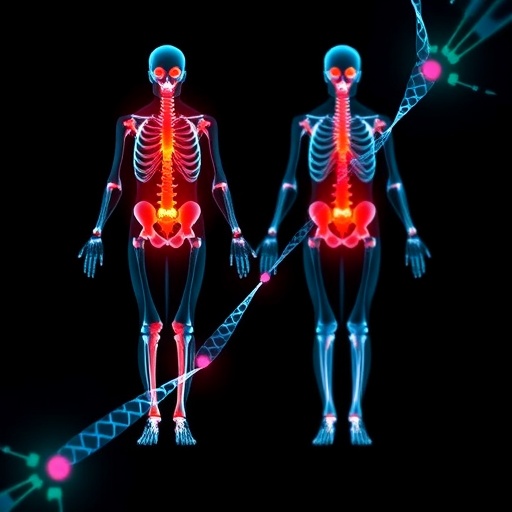In an era where precision medicine is rapidly transforming the landscape of healthcare, a new frontier is emerging in the treatment of orthopedic diseases through the use of nucleic acid aptamers. Aptamers, short strands of single-stranded DNA or RNA, have captured the attention of researchers for their remarkable ability to bind with high specificity and affinity to a broad range of biological targets. A recent comprehensive review published in the journal Bone Research has spotlighted the groundbreaking potential of aptamers in revolutionizing therapeutic strategies for a variety of complex bone disorders, from osteoporosis to osteosarcoma, and osteoarthritis.
This incisive review, led by Dr. Huan Liu of Southwest Medical University and Dr. Weihu Yang at Chongqing University, delves deeply into the molecular basis and biological mechanisms by which aptamers can be harnessed to enhance orthopedic treatment outcomes. Through the advanced selection processes of Systematic Evolution of Ligands by EXponential enrichment (SELEX), aptamers are engineered to precisely identify and interact with key molecular players implicated in bone health and regeneration. This targeted approach offers a significant advantage over conventional therapies, which often suffer from off-target effects and limited efficacy.
Aptamers’ unique structural properties confer several notable benefits that address many of the longstanding challenges in orthopedic therapy. Their intrinsic biological stability ensures durability in physiological environments, while their potential for universal chemical modification allows for fine-tuning of pharmacokinetics and biodistribution. Unlike viral vectors commonly used in gene therapy, aptamers exhibit low immunogenicity, minimizing the risk of adverse immune responses. Furthermore, their small size enables rapid tissue penetration, an attribute crucial for reaching dense and often avascular bone tissue.
The therapeutic versatility of aptamers becomes evident when considering their diverse target range. Among the critical signaling pathways modulated by aptamers are those driven by parathyroid hormone (PTH), bone morphogenetic proteins (BMPs), and the Wnt/β-catenin pathway—all essential regulators of bone remodeling and repair. By selectively binding to proteins and nucleic acid structures within these pathways, aptamers can fine-tune cellular activities to promote osteogenesis, inhibit tumor proliferation in bone cancers, and mitigate cartilage degeneration in arthritic conditions.
Importantly, aptamers also hold tremendous promise as vehicles within nonviral gene delivery systems. The current reliance on viral vectors for gene therapy poses safety risks including immune activation and insertional mutagenesis, as well as complex manufacturing challenges. Aptamer-functionalized nanoparticles and other nonviral platforms potentially offer safer, more cost-effective alternatives with improved targeting capabilities, enhanced cellular uptake, and efficient endosomal escape, which are critical determinants of successful gene delivery to bone tissue.
The SELEX methodology continues to evolve, yielding aptamers with improved specificity and binding efficiency. Recent advances include innovative adaptations such as Pro-SELEX and microfluidic-chip integrated SELEX, which streamline the selection process and reduce production costs. These cutting-edge techniques allow rapid identification of aptamers optimized for clinical use, moving the field closer to real-world therapeutic applications.
Despite the impressive progress, challenges remain before aptamer-based therapies can be fully integrated into orthopedic practice. Dr. Liu highlights the relative paucity of research on circular RNAs (circRNAs) within this context, a promising yet underexplored class of nucleic acids that may serve as novel biomarkers or therapeutic targets. Additionally, the refinement of screening processes is crucial to enhance accuracy, effectiveness, and economic feasibility, which will be essential for scaling up production and meeting regulatory standards.
The potential clinical applications are vast—aptamers could dramatically improve healing outcomes in fracture management by stimulating bone regeneration, aid in preserving alveolar bone integrity in dental procedures, and protect articular cartilage and osteochondral tissues from degenerative diseases. Moreover, their ability to differentiate and influence malignant bone cells introduces new hope for improved modalities in treating osteosarcoma, a highly aggressive bone cancer with limited current options.
From a translational research perspective, integrating aptamer technologies into existing therapeutic regimens represents a paradigm shift. The combination of aptamers with biomaterials, stem cell therapies, and 3D bioprinting holds particularly exciting possibilities for personalized medicine in orthopedics. This multidisciplinary approach could tailor treatments not only to the patient’s disease state but also to their unique genetic and molecular profile, thereby maximizing therapeutic efficacy.
As precision medicine continues to cement its role in the future of healthcare, nucleic acid aptamers stand out as a transformative tool specifically poised to address the unmet needs of complex bone diseases. Their design flexibility, target specificity, and favorable safety profile give them distinct advantages over traditional therapeutics and viral gene delivery systems. The insights gained from the ongoing research effort spearheaded by Dr. Liu, Dr. Yang, and their colleagues not only illuminate aptamer biology but also chart a roadmap toward clinical breakthroughs that could alleviate the burden of orthopedic ailments for millions worldwide.
In conclusion, while more research is mandated to close current knowledge gaps and optimize aptamer screening technologies, the horizon looks promising. With steady advances in molecular biology, nanomedicine, and bioengineering, aptamer-based interventions have the potential to redefine orthopedic treatment paradigms and potentially extend their benefits to other areas of medicine. The synergy of innovation, interdisciplinary collaboration, and persistent scientific inquiry will be key drivers in translating the promise of nucleic acid aptamers into tangible health outcomes.
Subject of Research: Not applicable
Article Title: Nucleic acid aptamers in orthopedic diseases: promising therapeutic agents for bone disorders
News Publication Date: 24-Jul-2025
Web References:
https://doi.org/10.1038/s41413-025-00447-8
References: Bone Research, 2025, DOI: 10.1038/s41413-025-00447-8
Image Credits: Dr. Huan Liu, Southwest Medical University




